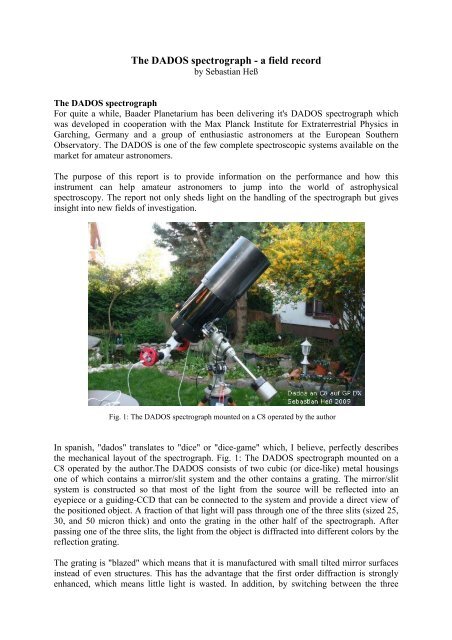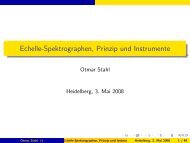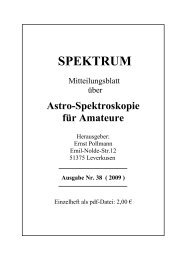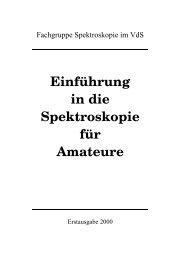The DADOS spectrograph - a field record
The DADOS spectrograph - a field record
The DADOS spectrograph - a field record
You also want an ePaper? Increase the reach of your titles
YUMPU automatically turns print PDFs into web optimized ePapers that Google loves.
<strong>The</strong> <strong>DADOS</strong> <strong>spectrograph</strong> - a <strong>field</strong> <strong>record</strong><br />
by Sebastian Heß<br />
<strong>The</strong> <strong>DADOS</strong> <strong>spectrograph</strong><br />
For quite a while, Baader Planetarium has been delivering it's <strong>DADOS</strong> <strong>spectrograph</strong> which<br />
was developed in cooperation with the Max Planck Institute for Extraterrestrial Physics in<br />
Garching, Germany and a group of enthusiastic astronomers at the European Southern<br />
Observatory. <strong>The</strong> <strong>DADOS</strong> is one of the few complete spectroscopic systems available on the<br />
market for amateur astronomers.<br />
<strong>The</strong> purpose of this report is to provide information on the performance and how this<br />
instrument can help amateur astronomers to jump into the world of astrophysical<br />
spectroscopy. <strong>The</strong> report not only sheds light on the handling of the <strong>spectrograph</strong> but gives<br />
insight into new <strong>field</strong>s of investigation.<br />
Fig. 1: <strong>The</strong> <strong>DADOS</strong> <strong>spectrograph</strong> mounted on a C8 operated by the author<br />
In spanish, "dados" translates to "dice" or "dice-game" which, I believe, perfectly describes<br />
the mechanical layout of the <strong>spectrograph</strong>. Fig. 1: <strong>The</strong> <strong>DADOS</strong> <strong>spectrograph</strong> mounted on a<br />
C8 operated by the author.<strong>The</strong> <strong>DADOS</strong> consists of two cubic (or dice-like) metal housings<br />
one of which contains a mirror/slit system and the other contains a grating. <strong>The</strong> mirror/slit<br />
system is constructed so that most of the light from the source will be reflected into an<br />
eyepiece or a guiding-CCD that can be connected to the system and provide a direct view of<br />
the positioned object. A fraction of that light will pass through one of the three slits (sized 25,<br />
30, and 50 micron thick) and onto the grating in the other half of the <strong>spectrograph</strong>. After<br />
passing one of the three slits, the light from the object is diffracted into different colors by the<br />
reflection grating.<br />
<strong>The</strong> grating is "blazed" which means that it is manufactured with small tilted mirror surfaces<br />
instead of even structures. This has the advantage that the first order diffraction is strongly<br />
enhanced, which means little light is wasted. In addition, by switching between the three
different slits or by changing the grating itself (which is done quite easily), the observer<br />
experiences the highest possible flexibility concerning the difficult compromise between<br />
spectral resolution and integration time.<br />
<strong>The</strong> <strong>spectrograph</strong> also features focusing optics which are connected in a 90 degree angle to<br />
the spectrometer. <strong>The</strong> focusing optics can easily be adjusted and fixed in place by a special<br />
screw. <strong>The</strong> angle of the grating can be adjusted with a micrometer and separately fixed in<br />
place. In this way a complete observation schedule can be done without the need to refocus or<br />
move the grating.<br />
First impression of the instrument<br />
Now we come to the first impression with the instrument. Fig. 2 shows two spectra of the Hα<br />
(Balmer) line of hydrogen in the spectroscopic double star β Aurigae with just one day<br />
difference. Due to the orbits of both stars, the emitted electromagnetic waves are either<br />
redshifted or blueshifted, depending on their velocity as seen on earth. <strong>The</strong>refore, the lines<br />
split in a periodic way. <strong>The</strong> lines on the right side are in the infrared and come from oxygen in<br />
our atmosphere. Hence they are excluded from the doppler shift.<br />
Fig.2: <strong>The</strong> Hα-line of the spectroscopic double star β Aurigae<br />
This image was taken over the course of two Northern European nights ;-) with the <strong>DADOS</strong><br />
<strong>spectrograph</strong>, an off the shelf CCD (Atik 214 E), and a reasonably aligned telescope mount.<br />
This illustrates what can easily be done with the <strong>DADOS</strong> <strong>spectrograph</strong> and equipment that is<br />
readily available to the amateur astronomer. To emphasize: To do spectroscopy of a bright<br />
spectroscopic double-star like β Aurigae (~1.9m), it is sufficient to use moderate equipment<br />
and 20 minutes of clear sky. However a lightweight (due to the 90 degree angle of the<br />
focusing optics) and cooled CCD like the Atik 214 seems to be crucial to receive highly<br />
resolved spectra.
Unfortunately, the system cannot be focused perfectly in a fast way due to optical aberrations<br />
occurring by the combination of the 90 deg geometry and the grating. This effect is increased<br />
with the higher resolution grating ( the 900 Lines/mm). However, by investing some time and<br />
effort the aberrations can be cancelled by a very exact focusing. One idea to deal with the<br />
problem is to leave the system composed and fixed once exactly focused. Or one uses the<br />
dovetail, also delivered by Baader Planetarium to switch between camera systems and<br />
eyepieces.<br />
Especially if using DSLR camera systems it is most useful to buy a focusing eyepiece - since<br />
exact focusing on the small screen is most painfull. It makes perfect sense to buy a 20mm<br />
(1.25") eyepiece, a second dove tail and a prolongiation adapter for the eyepiece. Here the<br />
astronomer has to play with the given possibilities. For focusing by eyepiece the moon or any<br />
other bright and extended lightsource with sharp linefeatures in it's spectrum is optimal. If<br />
there is no moon, the Neon lightbulb does a good job, but has the disadvantage of a necessary<br />
removal of the spectrometer from the telescope.<br />
Fig.3: <strong>The</strong> spectrum of sunlight reflected on the moons surface shows<br />
distinct Fraunhofer absorbtion lines.
Change of gratings and first tests with a DSLR camera<br />
Fig.4: Stars of different spectral class realized with the 200L/mm grating<br />
and a Canon 400D DSLR camera system.<br />
Even if the seduction to always use the highest spectral resolution is big, it makes perfect<br />
sense to use the lower resolution grating (200 L/mm) for darker objects or just to cover the<br />
complete visible range in just one single shot. For this work it is useful to prepare a clean<br />
working environment and to know the necessary steps in advance. In this way the danger of a<br />
destruction of one the gratings can be held as small as possible. With some training the<br />
process is inproblematic and can performed in less than 10 minutest.<br />
First, the mikrometer has to be unlocked. <strong>The</strong>n the second cube has to be opened and the old<br />
grating has to be unscrewed. <strong>The</strong>n the new grating can be inserted into the right position<br />
which is marked for both gratings individualy. <strong>The</strong>y are different since the diffraction angle<br />
differs with the number of lines per mm. Even for higher resolution gratings (1200L/mm ...)<br />
there are already marks prepared. Before starting the new observation session it is useful to<br />
find the new focus and to put the right part of the spectrum into the middle of the <strong>field</strong> of<br />
view. This can save a lot of time!<br />
Already with the standard 200 lines / mm grating, the <strong>DADOS</strong> <strong>spectrograph</strong> can be used to<br />
visualize the dominant features in the different spectral classes. <strong>The</strong> classes O,B,A,F,G,K;M
have developed historically and refer in this (modern) order to the surface temperature of the<br />
stars. That is why in the image, the hotter stars are on the top and the cooler stars are on the<br />
bottom. Hotter stars show other lines than the cooler ones.<br />
One reason for the different absorbtion line features at different temperatures is the<br />
appearence or absence of special excited or ionized states of the observed elements, which are<br />
described in detail by the <strong>field</strong> of plasma physics. In sloppy words: If all the hydrogen is<br />
ionized, there will be no H alpha absorbtion line due to the absence of any electron. But since<br />
the (Balmer series) H? line refers to an electron transition beween the second and the third<br />
main quantum number (orbit), the temperature of the star can also be too cool, since there<br />
must be enough excited hydrogen with electrons in the second orbit. Another reason is the<br />
existence of molecules at very low temperatures (see the many absorbtion line features a the<br />
M-Star).<br />
Preliminary Conclusion<br />
As a preliminary conclusion one might state that with the <strong>DADOS</strong> one gets good quality for<br />
the money. Especially for newcomers to spectroscopy the <strong>DADOS</strong> opens up the possibility<br />
for a fast but nonetheless deep jump into the <strong>field</strong>. Here details such as the integrated<br />
possibility for the positioning of guiding CCD's or eyepieces as well as the dove - tail system<br />
help a lot. But also the advanced amateur can have fun with these details, possibly with the<br />
higher resolution 900 L/mm grating.<br />
At this point it should be mentioned that there are systems on the market which provide a<br />
higher spectral resolution, but are much more expensive. Up to now I do not regret my<br />
decision for the <strong>DADOS</strong>. It is "Plug and Play!" - A long awaited dream coming true! How<br />
could the beginning be nicer?<br />
Outlook<br />
For those under you, awaiting the holy grale of high resolution spectroscopy: It must be<br />
mentioned that Baader Planetarium will soon provide us with a new spectrometer which has<br />
been developed by the same group of people. It is called the BACHES echelle <strong>spectrograph</strong>.<br />
<strong>The</strong> visitors of the ATT spectroscopy meeting 2009 in Essen were able to have closer look<br />
onto their prototype. And I must say: Wow! Without promising too much: This spectrometer<br />
is a big hit.<br />
For the first time, amateurs will be provided with a complete affordable Echelle <strong>spectrograph</strong><br />
system with an up to now amateur unreached spectral resolution. <strong>The</strong> complete visual spectral<br />
range in just one shot and a resolution of ?? / &lambda of up to 20000. That is a revolution.<br />
For reasons of comparison: Slit - Spectrographs on the market - also the <strong>DADOS</strong> - have a<br />
resolution of about ?? / &lambda ~ 4000. Following the keynote at the ATT spectroscopy<br />
meeting, the BACHES will cost about 6000 EUR and might be available starting this year.<br />
This will open up new possibilities, such as only few people worldwide have right now ...







